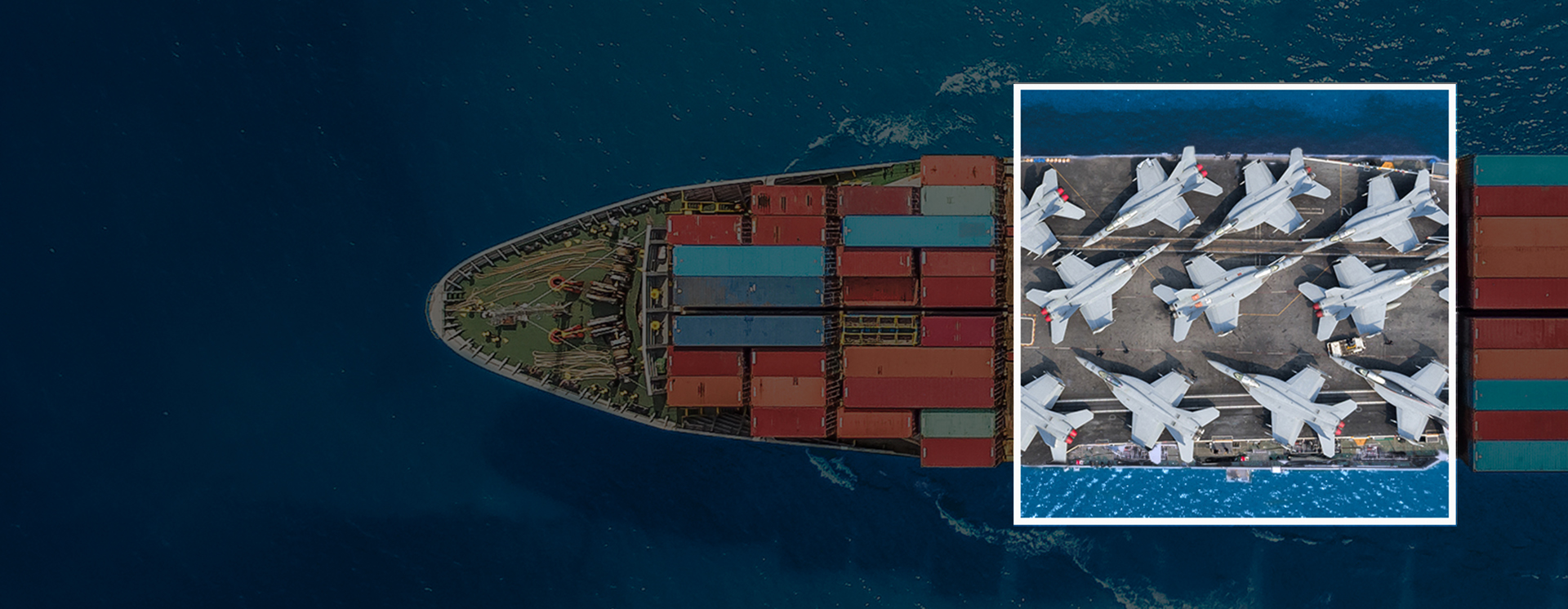Charting a course through geopolitical conflict
Food, electronics, critical medical supplies, cars, fuel - nearly all the world’s essential imports and exports are at sea at any given time. The security of these goods and a robust supply chain are vital for the functioning of modern society. A geopolitical conflict that threatens supply chain stability could threaten economic resilience around the world.
Geopolitical Conflict
The stakes are very high indeed. Many of the world’s key shipping gateways control access to high concentrations of vital resources, and the ability to control or deny access to this critical part of the supply chain can be a key weapon in the arsenal of governments willing to exert pressure on opponents or other nations.
Cutting access to just one of those routes could throttle up to 80% of one nation’s imports and energy[1]. If there were to be significant disruption to just a handful of shipping’s main chokepoints, several trillion dollars of trade value and business interruption costs would be at stake.
So far during the 21st century, conflicts have not risen to the point of catastrophic global trade disruption. However continued stability is not guaranteed. Climate change is increasing pressure on key resources, political extremism (potentially exacerbated by social media polarisation or misinformation) is on the rise, and cyber attacks and new civil conflicts are escalating.
As well as the shocking humanitarian impact of Russia’s invasion of Ukraine - 14.6 million people are thought to need humanitarian aid[2] - the subsequent conflict has opened our eyes to the complexities of maintaining key global exports and trade routes. Prior to the invasion in 2022, Ukraine and Russia produced 30% of global wheat and 55% of global sunflower exports, with the outbreak of hostilities causing severe disruptions to food supplies, particularly in the world’s poorest countries[3]. And as Ukrainian allies committed to phase out the use of Russian fossil fuels following the invasion, many nations had to implement emergency measures to settle the energy crisis that unfolded[4].
You can read more about the consequences of the conflict in Ukraine and the immediate response from the insurance industry in our report series ‘Ukraine: A conflict that changed the world’.
[1] https://gjia.georgetown.edu/2023/03/22/chinas-economic-security-challenge-difficulties-overcoming-the-malacca-dilemma/
[2] https://reporting.unhcr.org/operational/operations/ukraine#:~:text=An%20estimated%203.7%20million%20people,whom%20are%20women%20and%20children
[3] https://www.mckinsey.com/capabilities/strategy-and-corporate-finance/our-insights/war-in-ukraine-twelve-disruptions-changing-the-world
[4] https://www.iea.org/topics/russias-war-on-ukraine

The value of insurance
Insurance can be a safety net amid chaos and uncertainty. Our products provide people and businesses with a backstop against financial loss for countless risks worldwide and we provide guidance and expertise to help customers understand their vulnerabilities and strengthen their resilience.
The value of insurance extends to the compounding secondary impacts of geopolitical conflict, including delays and interruptions caused by trading partners or suppliers who are similarly impacted. We help businesses remain resilient and operational amid widespread disruptions and support public-private efforts to avoid global crises or shortages of vital commodities. Examples include:
Political risk insurance
Assets and funds located in politically volatile regions can be vulnerable in the event of unrest. Political risk insurance provides protection against losses from government actions like expropriation, currency inconvertibility, confiscation, contract breaches, and political violence.
Credit insurance
Political unrest can give rise to frozen funds, asset seizures and shipment delays, which may result in non-payment or non-fulfilment of contracts by trade partners or suppliers. Today, credit insurance stands behind over $3 trillion of global trade from losses due to non-payment of commercial debt, helping businesses protect their capital and cash flow.
Contingent business interruption (CBI) insurance
Businesses inevitably rely on other companies for raw materials, components, or products. If a supplier is unable to provide goods and services on time due to events such as geopolitical conflicts, it creates a knock-on effect down the supply chain, especially if alternative suppliers are unavailable. CBI insurance protects businesses from costs associated with declining turnover, loss of profit, and accrued charges caused by disruptions from third-party suppliers or customers, which impact the business’s ability to produce products or deliver services as usual.
Public-private partnerships
Collaborative initiatives between governments, NGOs and insurance have the power to tackle some of the complexities that can arise from the fallout of geopolitical conflict. Our market’s support for the UN-led Black Sea Grain Initiative enabled over 1,000 ships to leave Ukraine, carrying over 30 million tonnes of grain and fertilizer. These efforts have helped alleviate food shortages and market volatility at a critical time for global communities, as well as adding an estimated 5-8% to Ukraine’s GDP growth.

Picture the scene
The global economy is highly dependent on international trade. Whether lithium from Australia, semiconductors from Taiwan, or oil from the Gulf states, the world relies on the steady redistribution of critical resources. Added to this, a ‘just in time’ supply chain philosophy, where everything is shipped only when it’s needed, can mean that if conflict impacts even a single link in the chain, its effects could spread globally.
While the consequences of Russia’s invasion of Ukraine are real and significant, it is not inconceivable to imagine how a conflict involving actors with larger global trade interests could lead to even more severe consequences. Consider a superpower’s invasion of a neighbouring territory, setting off a cascade of events, including disruption to global trade patterns and supply chains. This is one hypothetical scenario, based on real world evidence, that demonstrates just how quickly a geopolitical conflict in one part of the world could cascade into global consequences:
Tensions rising
Following a regime change, tensions between a superpower, a neighbouring territory that controls access to critical shipping routes, and the wider political community begin to escalate.
Timeframe: Years

Hostile attack
The superpower launches an invasion on a neighbouring economy, marked by an internet blackout, cyber-attacks on critical infrastructure, and a physical blockade. The assault extends to strikes on air and land defences. The targeted economy suffers from the interference with its electricity generation, transport, and communications. Disruption to global trade begins.
Timeframe: Days

Alliances escalate conflict
The immediate response from another superpower, supporting the besieged territory, leads to a coalition of allied states forming on both sides. Vital trade routes around the territory are avoided by cargo ships, and both superpowers impose sanctions on each other amplifying the disruption of trade patterns, supply chains and the global flow of goods.
Timeframe: Months

Brinkmanship
Matters come to a head and, in response to sanctions, the country’s president threatens to close the shipping lanes, creating an unofficial war zone. Military exercises take place as a show of strength and declaration of intent. Opposing coalition forces amass in the region, ready to counter any efforts to seal access.
Timeframe: Weeks

Emergency powers
The superpower’s lawmakers seek to pass a bill preventing other states from using the shipping lane without the express permission of its Navy. Coalition forces, allied with the embargoed country, continue increasing their presence in the area.
Timeframe: Days

Diplomacy
Major governments engage in diplomatic negotiations with the superpower in an effort to open the shipping lane and avoid further escalations. However the continued presence of forces close to its borders is taken as an act of bad faith and the country’s leadership proceeds with closing the shipping lane.
Timeframe: Days

Paralysis
While foreign governments weigh up the options between a diplomatic or military response to the closure, the flow of goods through the area ceases. A military response has a knock-on effect, closing alternative routes and causing a cascading impact on a wide variety of supply chains, from raw materials, grain, construction equipment and microchips, slowing or effectively pausing global production. The reduced supply of goods leads to significant price rises of core and discretionary goods, adding inflationary pressure to already stretched economies.
Timeframe: Days

Stalemate and skirmish
The diplomatic standoff continues, tensions on the ground boil over and violence breaks out between rival factions. Critical infrastructure such as ports, power plants and other utilities are affected leading to shortages in essential resources. The need to divert military resources to the area puts governments on a war footing, shocking global financial markets and potentially impacting taxes and public spending. An extended closure and the involvement of multiple nations magnifies the economic fallout. Civil unrest across the world in reaction to the events grows.
Timeframe: Weeks to months
The severity of events and impacts
The extent to which countries around the world would be impacted by the geopolitical conflict and the closure of major supply routes would depend on their proximity to the affected area, the severity of the conflict and their dependency on the goods transiting through the region.
We have identified three potential levels of severity for this scenario: in all three the fighting takes place in the besieged territory and at no point are there territorial attacks on the superpowers or on any major powers.
| Level | Scenario severity descriptions | Historical reference |
| Major | Regional conflict: The invasion affects the immediate area with disruptions to shipping lines and supply chains. Conflict remains primarily between the invader and invaded territory. Other superpowers limit support to the supply of military equipment. Other major and minor powers do not get involved. Conflict impact lasts for one year. | Six Day War, 1967 |
| Severe | Involvement of major powers: The conflict intensifies as major powers intervene, deploying their own forces to counter the invasion. Conventional military engagements extend to surrounding areas, exacerbating the situation. Conflict impact lasts for more than a year. | Gulf War, 1991 |
| Extreme | Involvement of minor powers: The conflict expands further as minor powers also become involved, leading to widespread hostilities that extend beyond the initial region. This escalation results in prolonged disruptions to supply chains and global trade. Conflict impact lasts for more than three years. | North Korean invasion of South Korea, 1951 |
Historical references
The scenario - while hypothetical - has been informed by an analysis of historical events, including:
- Capture of Tibet (1950): People’s Republic of China sends forces into Tibet to end the de facto independence of the Tibetan government.
- Sino-India Border War (1962): Chinese forces capture Indian border regions of Aksai Chin and Arunachel Pradesh to settle their boundary dispute. The war results in de facto Chinese control of the two regions.
- Second Indo-Pak War (1965): A heavy incursion into the disputed Kashmir region by Pakistani forces led to an invasion by India across the international border. The war ends in an armistice and a retention of the territorial status quo.
- Falklands War (1982): The landing of Argentinian forces on the Falklands islands triggers a war with the United Kingdom which has had, and continues to have, de facto control of the Falklands. The war leads to a decisive British victory.
- Russian Annexation of Crimea (2014): Russian forces invade the Crimean Peninsula, holding a contested referendum to annex the territory from Ukraine.
- Russian invasion of Ukraine (2022): In a major escalation of the Russo-Ukrainian War, Russia launched air strikes and a ground invasion from the north (Belarus), east (Donbas) and south (Crimea). Russian attacks have included missile strikes on Ukraine’s critical energy and internet infrastructure.

Scenario effects
Looking at the bigger picture, the invasion of a major economy by a superpower has the potential to significantly reshape global dynamics and geopolitics. On the ground, combative conflicts inevitably cause humanitarian suffering, mass casualties and extensive physical damage to critical infrastructure. More broadly, protests and civil unrest in response to global events are likely.
Trade and physical supply chains
The economic impacts of this scenario stem primarily from severe damage to infrastructure in the invaded region driving the need for realignment of global trade networks. And as the conflict intensifies with sanctions and compromised shipping lines, businesses and governments must navigate through disrupted supply chains and adjust their strategic priorities.
Industries dependent on critical materials such as semiconductors and rare minerals – healthcare (medical devices), technology, automotive and many more – would likely face chronic shortages and delays.
While sectors like textiles and apparel are better positioned due to diversified supply chains, they could also experience short term disruptions.
The cascading effects of global trade disruptions, combined with escalating sanctions and closed shipping lines, is likely to drive inflation or food shortages in some states. Developing countries facing these challenges could experience heightened vulnerability to health crisis due to insufficient nutrition.
Internet outages and digital supply chains
Internet outages are likely during periods of geopolitical tension or unrest. They can occur in a few circumstances.
Competing superpowers can kinetically target satellites used for photographic surveillance (IMINT/GEOINT), signals intelligence (SIGINT), missile launch detection for interception, or navigational aid to military formations. This can unintentionally cause interference with commercial satellites, which underpin internet availability, due to the swirling debris in orbit.
Various world governments have also previously demonstrated their ability to “shut down” the internet. This can be within their own borders – such as President Hosni Mubarak disconnecting Egypt's four internet service providers (ISPs) in 2011, or the internet cut-off in the Kashmir region of India between August 2019 and March 2020 aimed at stemming protests after the revocation of a constitutional article guaranteeing the autonomy of the region.
Or it can be a targeted attack on a specific nation in conflict where online access is considered a critical weapon – in 2022 Russia attacked Ukraine’s internet to control the flow of information and broadcast Russian propaganda. Base stations, fibre-optic cables, and broadcasting antennae were captured or destroyed, and, in some regions, internet traffic was rerouted through Russian providers[5].
Finally, while servers or fibre-optic cables in a particular region may be the intended target of an attack, connection issues can spillover into neighbouring countries. A notable, innocent example occurred in 2011 when an elderly woman scavenging for copper in her garden in Georgia accidentally damaged a fibre-optic cable, leaving Armenia and large parts of Georgia and Azerbaijan without internet access[6].
During internet outages, online communication and operating systems, day-to-day functioning, transactions, and transportations are all halted. There is also a knock-on global impact on internet hosted critical infrastructure, travel, trade, and digital supply chains exasperating the physical issues already discussed. And a politically motivated attack on the internet has the potential to increase tensions between countries, as leaders seek accountability for the disruption.
Cyber attacks, particularly those targeted towards critical infrastructure, can also occur because of war between major powers. You can find out more about the threat of geopolitical cyber physical risk in our 2022 report linked below.
Explore the impact
The economic impact
The role of insurance
Disclaimer
This report has been produced by Lloyd's Futureset and Cambridge Centre for Risk Studies for general information purposes only.
While care has been taken in gathering the data and preparing the report Lloyd's and Cambridge Centre for Risk Studies do not, severally or jointly, make any representations or warranties on behalf of themselves or others as to its accuracy or completeness and expressly exclude to the maximum extent permitted by law all those that might otherwise be implied.
Lloyd's and Cambridge Centre for Risk Studies accept no responsibility or liability for any loss or damage of any nature occasioned to any person as a result of acting or refraining from acting as a result of, or in reliance on, any statement, fact, figure or expression of opinion or belief contained in this report. This report does not constitute advice of any kind.
Note that this report does not seek to replace or inform any of the mandatory scenarios which Lloyd’s publishes to support the Realistic Disaster Scenario exercises managing agents are required to undertake in respect of the syndicates managed by them.






